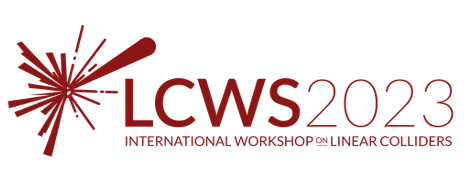Conveners
Accelerator: Normal Conducting RF
- Tetsuo ABE (KEK)
- Mohamed Othman (SLAC)
- Evgenya Simakov (LANL)
Accelerator: Normal Conducting RF
- Evgenya Simakov (LANL)
- Tetsuo ABE (KEK)
- Mohamed Othman (SLAC)
Accelerator: Normal Conducting RF
- Mohamed Othman (SLAC)
- Tetsuo ABE (KEK)
- Evgenya Simakov (LANL)
Accelerator: Normal Conducting RF: Accelerator: Normal Conducting RF
- Evgenya Simakov (LANL)
- Tetsuo ABE (KEK)
- Mohamed Othman (SLAC)
In the talk, I'll briefly introduce the C3 staged demonstration plan and its possible applications. The talk will cover technical demonstration and test setup for each stage.
TEX facility if commissioned for high power testing to characterize
accelerating structures and validate them for the operation on future
particle accelerators for medical, industrial and research
applications. At this aim, TEX is directly involved in the LNF leading
project EuPRAXIA@SPARC_Lab.
The brief description of the facility and its status will be provided.
An advanced Normal-Conducting RF (NCRF) C-band accelerating structure has been designed for a high gradient, high power e+e- linear collider linac in the TeV class. This design is attributed to the R&D advancement of an emerging class of distributed coupling accelerator topology exploring nominal cavity geometries. The accelerating structure features internal manifolds for distributing RF...
Future colliders will require injector linacs to accelerate large electron bunches over a wide range of energies. For example the Electron Ion Collider requires a pre-injector linac from 4 MeV up to 400 MeV over 35 m [1]. Currently this linac is being designed with 3 m long traveling wave structures, which provide a gradient of 16 MV/m. We propose the use of a 1 m distributed coupling design...
A preliminary study on C3-demo RF system layout has been conducted at SLAC. For the C3 demo facility, the study focused on main commercial off the shelf (COTS) RF components such as modulator, klystron, and waveguide components. A review of some issues for this hardware will be discussed in the frame of the problem future linear colliders.
The accelerating structure is a critical component of particle accelerators for medical, security, industrial and scientific applications. Standing-wave side-coupled accelerating structures with small apertures and nosecones are used when available rf power is at a premium and average current and average power lost in the structure are large. Meanwhile, typical on-axis coupled traveling wave...
High-gradient RF accelerator cavities must have absorbers for the suppression of the higher order modes (HOM). It was proposed that NiCr deposited into thin waveguide slots that run along a distributed coupling structure may provide adequate HOM absorption, for the proposed Cool Copper Collider (C3) accelerator design. Fabrication methodology for NiCr was recently developed at SLAC. At LANL we...
A C-band klystron is being developed to provide power to a fully integrated compact linear accelerator system. The design of this high-power RF source was centered on minimizing weight and volume. In doing so, a novel periodic permanent magnet focusing circuit was developed alongside a compact RF circuit to achieve > 50% efficiency in simulation. Fabrication of this system is underway and...
Concepts for future electron colliders such as the Cool Copper Collider (C^3) benefit from normal conducting radiofrequency (NCRF) cavities operated at cryogenic temperatures in many ways, including potential cost reduction and increased beam brightness. It is then advantageous to consider implementations of cryogenic electron linacs in order to study this new regime of cryogenic NCRF...
We present an RF and engineering design of a 1.6-cell RF photoinjector at 5.712 GHz. Two designs were developed: one for the room temperature and another one for cryogenic temperature operations. At Los Alamos we are constructing a facility for testing photocathodes that produce high-quality electron bunches under an intense RF electric field in excess of 100 MV/m. The basic 1.6-cell RF...
The progress on developing of dielectric disk accelerator will be presented. General challenges and future directions will be mentioned as well.
A simulation workflow is under development to interface particle data transfer and matching of geometry interface between the electromagnetic (EM) cavity simulation code ACE3P and radiation code Geant4. The target is to simulate dark current (DC) radiation effects for the KEK 56-cell S-band accelerating structure using ACE3P and Geant4, and benchmark against KEK experiment data. As a first...



